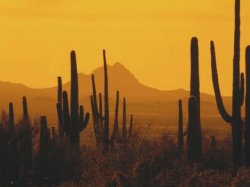What is the ecological succession?
 The saguaro cactus is part of a climax desert community in southwestern America.
The saguaro cactus is part of a climax desert community in southwestern America.
Desert biomes, defined by low annual precipitation, cover one-fifth of the planet. Under the umbrella term desert are some of the hottest and coldest places on Earth. Precipitation can vary among deserts as well, from arid climates with no precipitation, to those with an annual wet season, to semi-arid ecosystems that receive slightly more precipitation. Deserts may represent a wide range of conditions, but some aspects of desert succession can be seen across the planet.
Describing Succession
Succession can be thought of as ecosystem aging, but unlike human aging, it does not always move forward in an orderly fashion. During succession, species become established and are then supplanted when conditions become more favorable for another species. Succession usually follows a progression from colonizers through a series of intermediate stages until it reaches a climax community. Climax communities represent species assemblages that are relatively stable, unless the ecosystem is perturbed. Succession can be primary, where life starts out on completely new territory, or secondary, where succession is set back by a disturbance.
Primary Desert Succession
In deserts, primary succession could occur on a sand dune or a fresh lava flow. Bacteria or seeds of colonizing species find a foothold where a microclimate offers a pocket of increased moisture and protection. These original colonizers form biofilms and put down roots that stabilize the upper layer of soil and break down rocks. The improved soil can hold more moisture and support other plants, which crowd out the original colonizers. Eventually the ecosystem may be able to support grasses and finally woody shrubs, if there is enough water.
Secondary Desert Succession
Desert ecosystems can be disturbed by fire, flash flood scouring or land clearing. After disturbance, succession is set back, but the soil has already been developed. Secondary succession in deserts is relatively quick compared to primary succession, but it takes much longer to establish a desert community than it does in less arid regions. For example, in the southwestern deserts of North America, it can take 76 years to establish perennial plant cover and 215 years for full ecosystem recovery. If the disturbance is great enough, secondary succession may produce an entirely different climax ecosystem.

